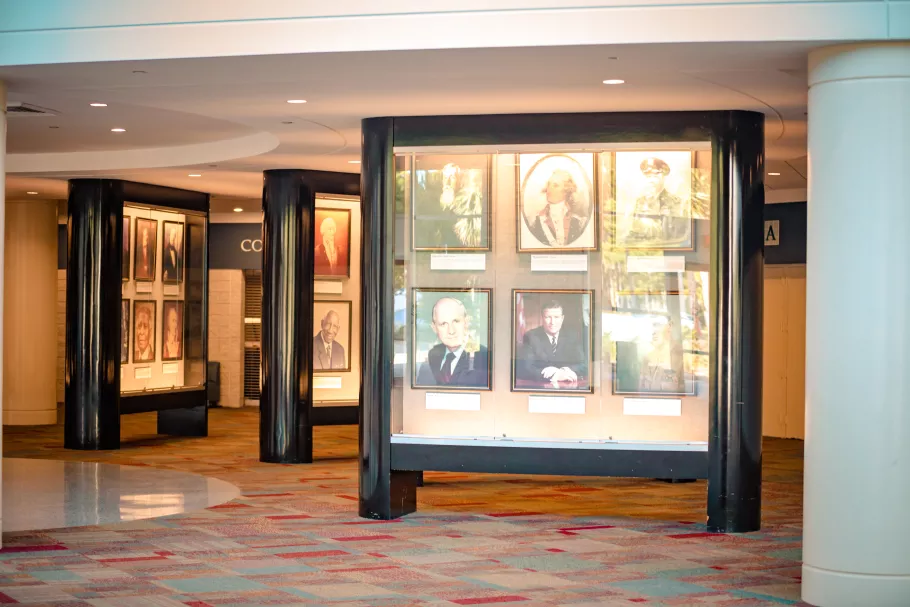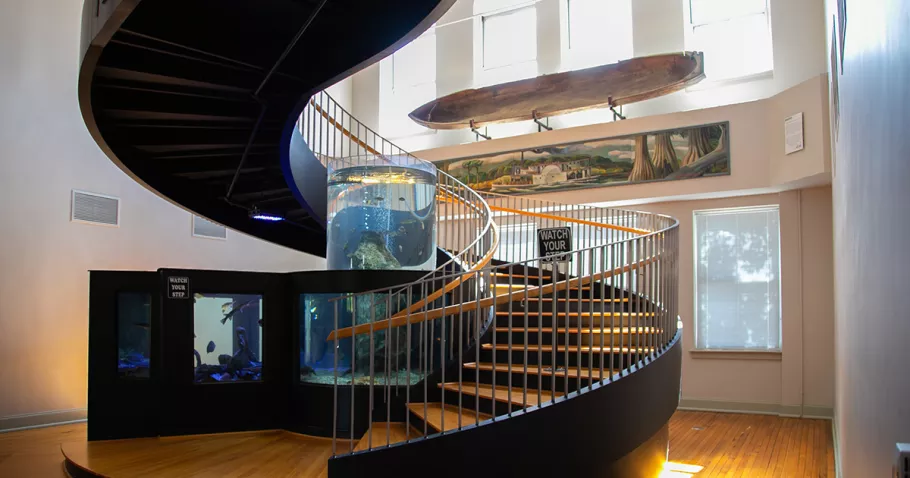The Myrtle Beach Area's Revolutionary War History

While Myrtle Beach has only been officially around since the early twentieth century, there is a good bit of Revolutionary War history that can be found along the Grand Strand. Hop in your car and check out the following locations.
South Carolina Hall of Fame
Myrtle Beach...Inside the Myrtle Beach Convention Center
Enter the glass doors on the front of the building just to the left of the Sheraton Hotel under the overhang that says South Carolina Hall of Fame. You will be met by display cases filled with portraits of our state's favorite sons and daughters (and a few we just claimed as ours) from every era of South Carolina's history. These are only some of the inductees. Others can be accessed digitally at the kiosk in the middle. The two most prominent figures honored for their service during the Revolution are Francis Marion, nicknamed the Swamp Fox, and Peter Horry. Regardless of your history training, these names may be familiar to you in Myrtle Beach because of their namesakes. The Swamp Fox is our 72-foot wooden roller coaster at the Family Kingdom Amusement Park (Family Kingdom Amusement Park and Splashes Oceanfront Water Park) and Horry County is where Myrtle Beach is located.

Withers Swash
Myrtle Beach...Where The Swashbuckler Disc Golf Course and the New Town Bark Park are located now
Centuries before Myrtle Beach came to be, Withers Swash was the location of Withers Plantation that was created as a result of the Revolution. The Withers Family, due to royal land grants, had multiple plantations near Georgetown, South Carolina, during the war. It was considered a relatively significant port town where British soldiers would headquarter for this region. But sometimes they would go marauding on those nearby plantations, and the Withers family had had enough. The head of the family had since passed away, so the Widow Withers and her adult sons decided to take advantage of a land grant they possessed in a relatively uninhabited region up the coast called Long Bay. They established Withers Plantation to initially grow indigo as they had done near Georgetown, but soon realized that cultivating the indigenous timber was far more lucrative. Today, adjacent to the dog park, you will find Withers Cemetery, but the Withers name doesn't appear on any of the headstones. It is believed two family members are interred there in unmarked graves.
William Bartram Trail Historical Marker
Myrtle Beach...Located at the entrance of Hurl Rocks Park
When our founding fathers declared our independence, it not only brought a time of war, but a time of exploration. One of the notable scientists of the day who was instrumental in cataloging the flora and fauna of our new country was William Bartram. His detailed notes, the sketches that he drew and the specimens that he collected formed the basis of a book that he published in 1791 that became one of our young nation's best-sellers. It gives a virtually unparalleled depiction of 18th century America. He is remembered in Myrtle Beach for his account of the "cliff of rocks" that we know today as Hurl Rocks. When I was a child, before our necessary beach renourishment began, the dark, spongy rocks were always on view. They were only as high as a toddler, so climbing on them was fun and easy. But you had to be careful because when the composite of peat and deteriorating sea life that formed the so-called rocks got wet, they were particularly slippery.
The Horry County Museum
Conway...Beside the public library
This institution is truly a local treasure. In their military exhibition gallery, they have, front and center, a replica of what a campsite would look like during the Revolutionary War. They reimagine how Francis Marion and Peter Horry would have lived while on the front lines. In addition, they display the clothes and accessories the patriots from this rural region would have worn. They didn't have the financial backing of the likes of the British military with their striking uniforms. Local soldiers simply wore what they would at home and provided their own weapons and supplies. When they weren't needed for fighting, they would return home to work their farms until they were summoned again. Horry was not only a comrade of Marion's, but he was his biographer. The exhibit includes notes like those Horry would have taken when documenting the military exploits of his friend, The Swamp Fox.

The Peter Horry / Horry County Historical Market
Conway...In front of the old courthouse
Peter Horry was born in Georgetown into a family of French Huguenot descendants; hence the "H" is not pronounced in his name. It doesn't take visitors to our area long to figure that out and correctly pronounce our county "O-ree." However, locals (I included) insist on mispronouncing it "Or-ree." I don't know why we collectively rebel against the proper pronunciation. We just do. Our county was named for Peter before his death to primarily honor his service during the Revolution. He was on hand in 1776 for the victorious battle at what we now know as Fort Moultrie, near Charleston. The fort was constructed of palmetto logs that were spongy enough to absorb the impact of the British cannon balls thereby facilitating our victory and garnering the tree a key position on our state flag. He continued to serve for the next few years but had given up his commission by 1780 when the British invaded our region forcing many local servicemen to surrender. Fortunately for South Carolina, Horry and Marion were not there and subsequently took to the swamps to instigate the guerilla warfare that they became famous for.
The Kingston-Conway / Robert Conway Historical Marker
Conway...In front of City Hall
Not only was Robert Conway a veteran of the Revolutionary War, but he was also Peter Horry's successor as Brigadier of the Sixth South Carolina Brigade. Therefore, it is fitting that the City of Conway is the County Seat of Horry County. While it was Peter Horry's military prowess that led to the county's naming, it was most probably the donation of 223 acres to the town by Robert Conway that influenced the change in that municipality's moniker 60 years after his death in 1823.
Hopeswee Plantation
Near Georgetown...Continue past Georgetown on Highway 17, it will be on the right
Not only was the home here definitely in existence during the American Revolution, it was the birthplace one of our founding fathers, Thomas Lynch, Jr., a signer of the Declaration of Independence. This is perhaps the most historic site in our region. Check their website for information on historic tours, cultural demonstrations, dining options and the opportunity to hold an event there. The centuries-old setting is both exceptionally beautiful and educational.

Marsh Tacky Horse
Murrells Inlet...At Brookgreen Gardens' Floyd Family Farm adjacent to the Lowcountry Zoo
Much of the success of the Swamp Fox and his men was due to their horses, the Marsh Tackies. Their name was derived from the terrain they were used in and "tacky" refers to the fact that they were common during the revolutionary years when everyone had one. Today, they are rare and facing near-extinction, but conservation efforts have increased their dwindling numbers four-fold in the last decade. Their ancestors were brought over to this continent by the Spanish in the 1600's as part of their effort to establish colonies. Subsequently, the horses were bred to endure the heat and the swampy topography of the Lowcountry. They are relatively small and are known for their mild-mannered dispositions, sure-footedness, and ability to perform well under stressful conditions. All of these desired qualities were almost entirely opposite of those possessed by the British equestrians who often found the swamps impenetrable while the Marsh Tackies took their riders right through. It is South Carolina's State Heritage Horse.
Kaminski House Museum
Georgetown...At one the end of the Historic River Walk
Before the Revolution, Paul Trapier of Georgetown was one of the wealthiest merchants in the colony. During the war, he was instrumental in provisioning the American troops. It is believed that his home that is now known as the Kaminski House existed during this time. It had been a gift to his unwed daughter whom he feared would not find a suitable husband. Perhaps it was the added bonus of the beautiful house overlooking the river or just her own allure, but Elizbeth Trapier did eventually wed Edward Martin, the Sheriff of Georgetown.
